 Leading Blog | Posts by Month |
 Leading Blog | Posts by Month |
08.31.12

LeadershipNow 140: August 2012 Compilation
Posted by Michael McKinney at 09:23 PM
08.28.12

There is an I in Team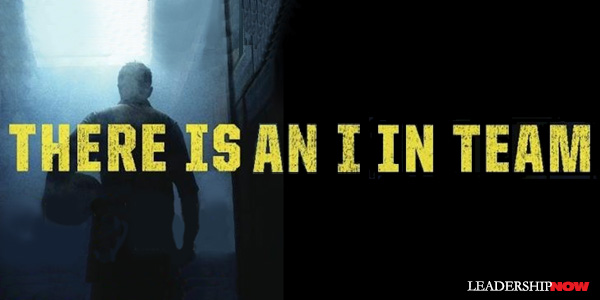
THE often repeated phrase, “There’s no ‘I’ in TEAM” is only half true. It ignores the fact that great teams have great individual members. And high performing teams are not always easy places to be. Mark de Rond acknowledges in There Is an I in Team, that “with few exceptions, the qualities that make individuals as gifted as they are can make them wearisome as team members.” Great team members are often perfectionists, paranoid, stubborn and/or self-confident. But they do perform. “Team leadership is as much about mitigating the risks of these traits as it is about exploiting their potential.” David Whitaker, one of Britain’s most distinguished coaches wrote in The Spirit of Teams, “If you want an exceptional team, keep your eye on the individual … Teams thrive on individual choice and commitment … the most powerful teams are made up of individuals who have chosen to work as a team.” Using fresh examples, de Rond tackles other realities of teams: On high performance teams, everyone is not equal. Star performers increase a team’s overall effectiveness but only to a point. If the proportion of stars versus average members exceeds much beyond about 50%, you begin to experience diminishing returns. Of course, emotional intelligence plays a part. De Rond reports that “if someone is strongly disliked, it is almost irrelevant whether or not he is competent. By contrast, if someone is liked, her colleagues will seek out every bit of competence she has to offer, meaning that a little likeability has far more mileage than competence in making someone a desirable team member.” Without internal competition, teams may underperform. Too much harmony can hurt team performance. “A healthy level of internal competition can help get the best out of high performers.” Citing Timothy Gallwey, De Rond explains, “each player tries his hardest to defeat the other, yet not for the sake of beating another player, but merely to overcome the obstacle he now presents.” Interestingly, one study de Rond offers, finds that often team members value charitable individuals much less than we might expect. After a team activity, members were asked which people they would eliminate. Not surprisingly, the selfish people were unpopular, but so were the most selfless. One explanation was that “seeing others take less than their fair share made them feel bad, and that the only way to rescue their own reputations was to eliminate the martyr. Virtue had become a vice.” While we want everyone to be on the same page, people have different versions of reality. Whether or not they are correct is less relevant than what their realities tell you about their priorities. “At the root of much team conflict is disagreement on why things are as they are and not otherwise, which too easily escalates as colleagues begin to question each other’s motives. To recognize explanations for what they are—a visceral reminder of what matters to people personally—is often a good first step to calming the waters.” De Rond also deals with social loafing or why productivity tumbles with size. An interesting series of studies show that productivity and team size is less an issue of coordination and more a problem of contribution. Team members are “more likely to optimize their performance when faced with slightly fewer members than the task at hand requires.” Management consultant Kal Bishop found that with creative teams in particular, larger teams were inclined to seek consensus rather than explore novel ideas. Understanding and managing our humanity is key to leading teams. De Rond concludes: “Team leaders may choose to increase their reliance on sophisticated technological gadgets to up performance but will only ever be effective when they use these tools to unlock that basic, shared humanity. And, then, not by dispensing solutions, but by knowing what questions to ask and when.”

Posted by Michael McKinney at 10:22 AM
08.24.12

Leadership as Provocative Competence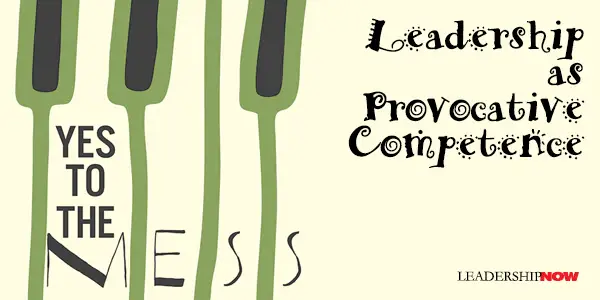
J Barrett introduces us to what he calls Provocative Competence. It is the capacity “to create the discrepancy and dissonance that trigger people to move away from habitual positions and repetitive patterns.” Barrett says “Leadership as a design activity means creating space so that people will be tempted to grow on their own.” Herbert Simon, who won the Nobel Prize in Economics in 1978 for his research on decision making in organizations, believed that we should not think of leaders as making decisions on past data, “but as creating forms so that people can flourish in the future,” or as Barrett expresses more clearly, as shaping “worlds of interpretation in which others can make meaningful contributions.” The outcome then, is to enliven activity and rouse the mind to life. It isn’t about authority but is “relational moves within an unfolding context” and are judged by “how well they work with the resources at their disposal … and how effectively they help free their own potential and that of others.”Barrett breaks provocative competence down into five component parts: First, it is an affirmative move. “What makes these interventions powerful is that the leader holds a positive image of what others are capable of. This often means seeing other people’s strengths better than they see their own strengths.” Second, provocative competence involves introducing a small disruption to routine. “What makes provocative competence an ‘art’ is the introduction of just enough unusual material that it engages people to be mindful—to pay attention in new ways.” Timing and pacing is important he cautions. “Leaders who disrupt on a regular basis or try to be provocative all the time are obnoxious, and are eventually ignored and probably mimicked.” Third, it is important to create situations that demand activity. People are expected to jump in and work it out and discover as they go. Fourth, provocative competence means facilitating incremental reorientation by encouraging repetition. There is a balance here. “Not all repetition is the same. Sometimes you need to repeat a gesture and then start to notice it from a slightly different angle…. Even while people are learning on old habits, they have to attend to new cues and new options, and start to manage and process information within a new, broader context.” Fifth, provocative competence involves analogic sharpening of perspectives and thought processes. “This is the point at which people look back at what is emerging and jump into the morass as they make comparisons, links, and connections to a larger, emerging whole.” This is the thrust of innovation. Net effect: “People start to notice affinity between pieces that previously seemed disconnected; resemblances that no one noticed before start to emerge.” Of course, notes Barrett, “different groups have different levels of performance, and leaders certainly have to deal with imperfect talent, but saying yes to the mess means finding affirmation in the best of what already exists.” That’s the job of a great leader. It’s what separates leaders from bosses. “That’s a true gift: to be able to see people at their very best when their current behavior is far less than that.” Of Related Interest:

Posted by Michael McKinney at 05:59 PM
08.21.12

The Main Thing: How to Keep Organizations Centered on What Matters Most "The main thing is to keep the Main Thing the main thing!" We loved that expression when we first heard it from Jim Barksdale, then the COO of FedEx. That single sentence captures the greatest challenge that executives and managers face today: keeping their people and their organizations centered on what matters most. Every organization needs a Main Thing—a single, powerful expression of what it hopes to accomplish. Without it, it's not possible to align the four elements that produce organizational efficiency and effectiveness: strategy, people, customers, and processes. Does your organization have a Main Thing? Do your people understand it? Are they guided by it? Fred Smith, the Founder and CEO of FedEx, once described to us his understanding of The Main Thing—which he refers to as the "theory of the business." Every successful business has, at its heart, a theory of the business—an underlying set of supporting objectives and a corporate philosophy that gives people a foundation on which to operate. Working inside that framework, they've got an idea of what we want them to do—to prioritize. We [at FedEx] have a very clear business mission and a business theory which is understood certainly by every member of the management team, and probably by 90 percent of the work force."The Main Thing is critically important. It is the end that strategy and human effort serve. We cannot achieve and maintain alignment without consensus and conviction about The Main Thing. Yet we are always amazed by how few people can articulate their organization's main thing. When we ask participants in workshops, "What's your Main Thing?" we see people digging into their wallets for the latest mission statement. Others look questioningly to the person sitting next to them. We wonder how these people can formulate a strategy or know how well they are doing if they cannot even state—or agree on—the ultimate purpose of their work. Some people, however, can articulate their Main Thing without hesitation. Here are a few examples:
What is The Main Thing for your organization? Can you articulate it clearly and concisely? Can your subordinates? In many organizations, people have no clear answer, or will offer a confusing list of lofty goals. Others will describe their strategy. But a strategy is not The Main Thing; it is merely its servant. In some cases senior management defines The Main Thing one way and the people in the trenches define it in another. In these cases people and policies work at cross-purpose; one person is pulling when the other guy is pushing. As you formulate a Main Thing for your organization, keep these guidelines in mind:
Dr. George H. Labovitz is the founder and CEO of ODI, an international management training and consulting company, and professor of management and organizational behavior at the Boston University Graduate School of Management. Victor Rosansky is co-founder and president of LHR International, Inc. He has more than 25 years of experience as a consultant, helping Fortune 500 clients to drive rapid strategy deployment and alignment. 
Posted by Michael McKinney at 02:39 PM
08.17.12

Heroic Leaders and Passive Followers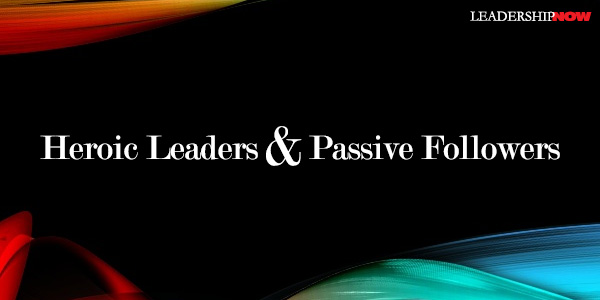
AS leaders, if we take too much control and do not encourage others to take responsibility, we set ourselves and others up for failure. Roger Martin calls it the responsibility virus and it always begins with the germ of fear. “This vacillation between over- and under-responsibility is an endless loop. Fear of failure drives them into an initial extreme position. The extreme positions of over- and under-responsibility drive them into failure. Failure causes them to flip into the other extreme. And so on.” He adds that “Advising leaders to stop being heroic and exhorting passive followers to become more aggressive doesn’t get the job done. Heroic leaders and passive followers are pursuing what they feel, at that time and place, to be the optimal course of action.” But it is destructive. Yet we see it played out all the time in organizations, in part because we have a hard time wrapping our minds around the true function of leadership. Martin explains that “Take-charge leadership is the stuff of Hollywood and history books, deeply ingrained in our consciousness.” A heroic leader is one who takes on more responsibility than they can handle. And it undermines rather than builds followers. In an article for the Stanford Innovation Review, Martin writes: “Take-charge leadership misapplied not only fails to inspire and engage, it produces passivity and alienation. “When leaders assume 'heroic' responsibility for making critical choices, when their reaction to problems is to go it alone, work harder, and do more – with no collaboration or sharing of leadership – their 'heroism' is often their undoing. “Such action often leads to an organizational affliction I have dubbed the 'responsibility virus.' A leader senses a subordinate flinch under pressure and responds by taking a disproportionate share of responsibility, prompting the subordinate to hesitate and become passive. The heroic leader reacts by leaping to fill the void. The passive employee retreats further, abdicating more responsibility, becoming distant, cynical, and lethargic. The leader, unable to cope with an impossible workload, becomes contemptuous and angry. A once-promising project becomes rudderless and spirals toward failure.” Are you acting over-responsibly?
Posted by Michael McKinney at 07:02 PM
08.16.12

Behaviors and Mindsets that Ruin CareersBill Lane was Jack Welch’s speechwriter for nearly two decades. In Losing It, he draws on his experiences primarily at GE to highlight the behaviors that are career killers. Naturally, Welch figures into much of this book. Reading the stories you might recognize a few areas where you may need to rethink your approach or behavior.Most of his insights are the kind of common sense that we easily see overlooked by others but forget to put into practice in our own lives. Here is a selection of ideas to think about: The best advice I can give anyone in management in business, organizations, politics, the military, or life in general is to fight and strive endlessly to expand your responsibilities and never stop, never coast, never get comfortable, no matter how many people tell you how great you are and how well you are doing. “Show off” with actions, never words. “You need to ask yourself every day of your career, ‘Am I up to speed? Am I pushing the envelope, or am I stagnating and falling behind?’” Are you still living off the same achievement you had 20 years ago? The ultimate sustainable advantage in your career is the ability to learn. Incuriosity leaves you vulnerable to lies and dissembling. Good leaders put their heads down and do what has to be done, within the inflexible ropes of absolute integrity. “Superficiality—[managing at too high a level] – leads you to decisions that I think are ‘glossy’—made at too high a level, without real understanding of the data—and leads to decisions that do not account for key data, such as risk.” Without real diligence, the organization slides into a mindset of slack. “Uninvolved” emperors or empresses (at any level) usually design elaborate and sometimes clever mechanisms to protect themselves from the vulnerabilities and snickers caused by their feckless or disconnected behavior. Very few people have ever gotten hurt by keeping their mouths shut. Of Related Interest: 
Posted by Michael McKinney at 11:59 AM
08.14.12

Triple Crown Leadership
WITH far too much failed leadership on display, leaders should commit to building a different brand of leadership—Triple Crown Leadership, say authors Bob and Gregg Vanourek. Triple Crown leaders have the goal of building and sustaining organizations that are excellent (high performance), ethical (do the right thing), and enduring (stand the test of time). As with the Triple Crown in thoroughbred horseracing, it is an epic quest that is audacious but not impossible. Triple Crown leaders integrate five practices that build excellent, ethical, and enduring organizations: Seek “head and heart.” The first step is putting together a triple crown team. Typically we look for people with the right “head” skills (experience, education, expertise), but they must have the intangible “heart” qualities (character, integrity, courage). Post “colors.” An organization’s “colors” are its purpose, values, and vision. Leaders must engage all in developing the colors through a collaborative process, thereby increasing ownership and buy-in. People are free to act as long as they do so in accordance with the colors. Flex between “steel and velvet.” Triple Crown leaders cannot remain stuck in their normal style of leadership. They lead by flexing between the hard and soft edges of leadership, sometimes in command, other times willingly soliciting and following the leadership of others. If your actions are consistent with the colors—purpose, values, and vision—you will not appear inconsistent in your approach. Unleash “stewards.” Stewardship is everyone’s responsibility. It’s not empowerment handed down from the top but a culture where the freedom to act is expected as long as they act in accordance with the shared values and vision of the organization. It’s automatic. “Triple Crown leadership ebbs and flows dynamically from person to person—up, down, and around—depending on the person’s knowledge, skills, passion, and the nature and urgency of the challenge at hand.” (Look on pages 114 to 123 for lists of specific ideas on how boards, CEOs, managers, and people without authority can become Triple Crown stewards.) “Align.” Alignment builds trust. Alignment speeds up the process. Alignment should be collaborative, start where you are and cascade, and be flexible. It requires some finesse to get people on the same page while protecting the innovative mavericks and creating the conditions for operating in a state of flow. There is a big difference between completing an alignment exercise at a one-shot retreat and actually creating an aligned organization, between having a purpose statement and being purpose-driven, between having values and upholding them when the pressure is on, between saying you are vying for the triple crown and actually aligning the enterprise to achieve it. The five triple crown leadership practices are related and mutually reinforcing. Building excellent, ethical, and enduring organizations requires a commitment from many people over many years, and the view that leaders exist at all levels. 
Posted by Michael McKinney at 10:31 PM
08.08.12

Leadership by Choice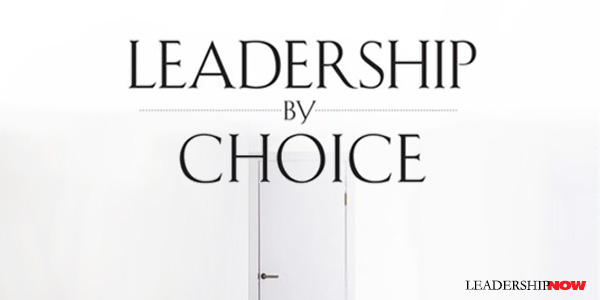 LEADERSHIP is always a choice. In Leadership by Choice, author Eric Papp says it means “making a conscious choice to positively influence those around you by managing yourself and leading others in four areas: communication, leading teams, productivity, and personal development.”
LEADERSHIP is always a choice. In Leadership by Choice, author Eric Papp says it means “making a conscious choice to positively influence those around you by managing yourself and leading others in four areas: communication, leading teams, productivity, and personal development.”
Communication — How well do you listen, ask questions, and speak with influence? How many of our problems are caused by a lack of listening? We listen better to people we like, but we can learn to listen with liking to anyone. What prevents us from doing so is preconceived ideas and ideas that we have about someone. “Sometimes while listening to someone, thoughts flood your mind – “can this person do anything for me?” “I probably won’t like this person,” or “Who likes them anyway?” – influencing how you listen.” Listen with liking. Leading Teams – How well do you establish trust, healthy conflict, and achieve results with others? A culture of blame teaches people that they can avert their own responsibility by blaming others. “When you breed and teach a culture of no accountability, it’s very hard to reach anything above mediocrity.” Without accountability you can’t lead. Papp suggests five ways to hold yourself accountable: 1. Don’t overextend yourself; 2. Take action before you speak. Actions speak louder than words; 3. Have an accountability partner; 4. Chart your progress. Write down daily or weekly actions that chart your continual growth; 5. Aim for consistency, not perfection. Productivity – How well do you spend your time and how focused are you? You are responsible for being productive. Know where your time is going, plan the day before, focus on high-payoff items, and delegate for results and not the process. (Forcing someone to do things your way is not delegating for results. It makes for a very stressful environment and is also counterproductive.) Personal Development – What are you doing to develop yourself? Where do leaders find their inspiration? “When we retreat to silence, we tap into the inner calm that allows us to search for answers.” Lead with silence. We must learn to deal with stress. Papp suggests that we enjoy silence, create a gratitude list, get your sleep and take naps, allow for mistakes, help someone (giving is a great stress reducer), and make a decision to enjoy life. 
Posted by Michael McKinney at 08:25 AM
08.06.12

The Pivot Point of Organizational Change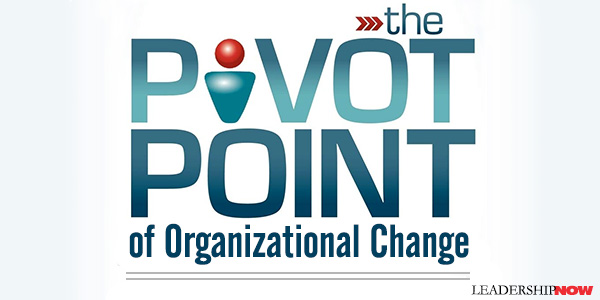
WE know that the vast majority of organizational change initiatives fail. Why? The general answer is our resistance to change. But what if it’s something else? In The Pivot Point, authors Victoria and James Grady ask, “What if this is not a ‘resistance’ problem for which the organization must engineer a solution, but a deeper ‘people’ problem that the organization must first learn to understand and respect?” Perhaps the problem is less about resistance to change and more about attachment to some thing. Change involves destruction and insecurity. You have to give up something to create something new. It’s the nature of change. Sometimes it is very hard to give up that thing. It creates anxiety, frustration and insecurity. “We form attachments to objects unique to our organizational environment and we lean on them for support.” What we react to is our loss of attachment. The essence of the problem is not resisting change per se, but resisting the distress inherent in somehow losing the objects that we attach to or lean on in our work environment. These objects can be people, systems, places, things, or even abstract concepts such as ideas or environments—anything that provides us with a sense of “attachment” to the organization. If this is the case, then the challenge is to identify those attachments and the impact the proposed change will have on them, and design a solution around them—introducing changes will maintain healthy attachments. The authors refer to this as the Pivot Point of organizational change success: “when we recognize the significance of our individual reaction to organizational change, take appropriate steps to support healthy attachment behaviors, and make use of current information to optimize the situation for all concerned.” The authors suggest that “to mitigate the negative effects of losing our sense of stability, one way an organization can ease the transition of a change initiative is to look for a generic substitute to replace the lost object until a new sense of stability is restored. Those replacements could be “a leader, a favored object, a method of communication, a continuing education series, a technology, a colleague, a culture, or any combination of these items.” They also present other methodologies to prevent or modify symptoms before or as they are developing. It is possible to discover which symptoms are most likely to escalate, allowing you to implement a strategy to mitigate these symptoms before you ever begin your organizational change initiative.

Posted by Michael McKinney at 06:28 PM
08.01.12

First Look: Leadership Books for August 2012Here's a look at some of the best leadership books to be released in August.




For bulk orders call 1-800-423-8273  Build your leadership library with these specials on over 120 titles. All titles are at least 40% off the list price and are available only in limited quantities. “I find television very educating. Every time somebody turns on the set, I go into the other room and read a book.” — Groucho Marx
Posted by Michael McKinney at 07:00 AM
|
BUILD YOUR KNOWLEDGE


How to Do Your Start-Up Right STRAIGHT TALK FOR START-UPS 
Grow Your Leadership Skills NEW AND UPCOMING LEADERSHIP BOOKS 
Leadership Minute BITE-SIZE CONCEPTS YOU CAN CHEW ON 
Classic Leadership Books BOOKS TO READ BEFORE YOU LEAD |
|